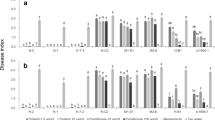Abstract
Cucurbit powdery mildew caused by Podosphaera fusca limits crop production in Spain. Since its management is strongly dependent on chemicals, the rational design of control programmes requires a good understanding of the fungicide resistance phenomenon in field populations. Fifty single-spore isolates of P. fusca were tested for sensitivity to three quinone-outside inhibiting (QoI) fungicides: azoxystrobin, kresoxim-methyl and trifloxystrobin. Minimum inhibitory concentration (MIC) values for QoI-sensitive isolates were found to range from 0.25 to 10 μg ml−1 for azoxystrobin to 5–25 μg ml−1 for kresoxim-methyl, using a leaf disc-based bioassay. High levels of cross-resistance to QoI fungicides were found. Eleven isolates showed resistance to the three QoI fungicides tested with MIC and EC50 values >500 μg ml−1 resulting in RF values as high as >715 and >1000 for trifloxystrobin and azoxystrobin, respectively. A survey of P. fusca QoI resistance was carried out in different provinces located in the south central area of Spain during the cucurbit growing seasons in 2002, 2003 and 2004. Examination of a collection of 250 isolates for QoI resistance revealed that 32% were resistant to the three fungicides tested; the provinces of Ciudad Real, Córdoba and Murcia being the locations with the highest frequencies of resistance (44–74%). By contrast, no resistance was found in Badajoz, and relatively low frequencies were observed in Almería and Valencia (10–13%). Nearly 50% of resistant isolates were collected from melon plants. Based on these data, recommendations about the use of QoI fungicides for cucurbit powdery mildew management in the sampled areas are made.
Similar content being viewed by others
References
Álvarez B, Torés JA (1997) Cultivo in vitro de Sphaerotheca fuliginea (Schlecht. ex. Fr.), efecto de diferentes fuentes de carbono sobre su desarrollo Boletín de Sanidad Vegetal Plagas 23: 283–288
Anke T, Oberwinkler F, Steglich W, Schramm G (1977) The strobilurins-new antifungal antibiotics from the basiomycete Strobilurus tenacellus Journal of Antibiotics 30: 806–810
Anon. (2005) International FRAC QoI Working Group Minutes (www.frac.info)
Bartlett DW, Clough JM, Godwin JR, Hall AA, Hamer M, Parr-Dobrzanski B (2002) The strobilurin fungicides Pest Management Science 58: 649–662
Becker WF, von Jagow G, Anke T, Steglich W (1981) Oudemansin, strobilurin a, strobilurin b, and myxothiazol: new inhibitors of the bc1 segment of the respiratory chain with an e-β-methoxy-acrylate system as common structural element FEBS Letters 132: 329–333
Bohr VA, Anson RM (1999) Mitochondrial DNA repair pathways Journal of Bioenergetics and Biomembranes 31: 391–398
Braun U (1987) A monograph of the Erysiphales (powdery mildews) Beiheftezur Nova Hedwigia 89: 1–700
Braun U, Cook TA, Inman AJ, Shin H-D (2002) The taxonomy of powdery mildew fungi. In: Bélanger RR, Bushnell WR, Dik AJ, Carver TLW (eds.) The Powdery Mildews. A Comprehensive Treatise. APS Press, St. Paul, MN (pp 13–55)
Brent KJ and Hollomon DW (1998) Fungicide resistance: The assessment of risk. FRAC Monograph No. 2. GCPF, Brussels
Del Pino D, Olalla L, Pérez-García A, Rivera ME, García S, Moreno R, de Vicente A, Torés JA (2002) Occurrence of races and pathotypes of cucurbit powdery mildew in southeastern Spain Phytoparasitica 30: 459–466
Délye C, Corio-Costet MF (1998) Origin of primary infections of grape by Uncinula necator: RAPD analysis discriminates two biotypes Mycological Research 102: 283–288
Gisi U, Sierotzki H, Cook A, McCaffery A (2002) Mechanisms influencing the evolution of resistance to Qo inhibitor fungicides Pest Management Science 58: 859–867
Heaney SP, Hall AA, Davies SA, Olaya G (2000) Resistance to fungicides in the QoI-STAR cross-resistance group: current perspectives. Proceedings, BCPC Conference-Pests and Diseases. Brighton, UK (pp. 755–762)
Ishii H, Fraaije BA, Sugiyama T, Noguchi K, Nishimura K, Takeda T, Amano T, Hollomon DW (2001) Occurrence and molecular characterization of strobilurin resistance in cucumber powdery mildew and downy mildew Phytopathology 91: 1166–1171
Keinath AP, DuBose VB (2004) Evaluation of fungicides for prevention and management of powdery mildew on watermelon Crop Protection 23: 35–42
Kraiczy P, Haase U, Gencic S, Flindt S, Anke T, Brand U, Von Jagow G (1996) The molecular basis for the natural resistance of the cytochrome bc1 complex from strobilurin-producing basidiomycetes to center Qo inhibitors European Journal of Biochemistry 235: 54–63
McGrath MT (2001) Fungicide resistance in cucurbit powdery mildew: Experiences and challenges Plant Disease 85: 236–245
Olalla L (2001) Etiología, biología y epidemiología del oídio de las cucurbitáceas en cultivos bajo plástico. PhD thesis, Universidad de Málaga, Málaga
Pérez-García A, Mingorance E, Rivera ME, del Pino D, Romero D, Torés JA, de Vicente A (2006) Long-term preservation of Podosphaera fusca using silica gel Journal of Phytopathology 154:190–192
Sitterly WR (1978) Powdery mildew of cucurbits. In: Spencer DM (ed.) The Powdery Mildews. Academic Press, London (pp 359–379)
Texeira de Sousa JA (1985) Lutte contre Rosellinia necatrix (Hartig) Berlese, agent du “pourridié laineux”: Sensibilité de quelques espèces végétales et lutte chimique European Journal of Forest Pathology 15: 323–332
Torés JA, Cánovas I, Velasco MV (1990) Nota sobre Sphaerotheca fuliginea (Schlecht. ex Fr) Poll., agente causante del oídio de las cucurbitáceas en la zona costera de las provincias de Málaga y Almería Investigación Agraria 5: 475–479
Zitter TA, Hopkins DL, Thomas CE (1996) Compendium of cucurbits diseases. APS Press, St. Paul, MN
Acknowledgements
This study was funded by grants from Plan Nacional de Recursos y Tecnologías Agroalimentarias of Ministerio de Educación y Ciencia, Spain (AGL2001-1837 and AGL2004-06056). The authors thank M.T. MacGrath (Cornell University) for critical reading of the manuscript and I. Cánovas (EE La Mayora) for excellent technical asistance. The authors also thank M. Bardin (INRA Montfavet) and N. Fanourakis (TEI Heraklion) for kindly providing French and Greek reference P. fusca strains.
Author information
Authors and Affiliations
Corresponding author
Rights and permissions
About this article
Cite this article
Fernández-Ortuño, D., Pérez-García, A., López-Ruiz, F. et al. Occurrence and distribution of resistance to QoI fungicides in populations of Podosphaera fusca in south central Spain. Eur J Plant Pathol 115, 215–222 (2006). https://doi.org/10.1007/s10658-006-9014-7
Accepted:
Published:
Issue Date:
DOI: https://doi.org/10.1007/s10658-006-9014-7




